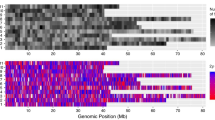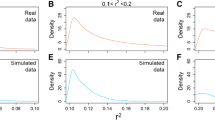Abstract
Key message
Heuristic genomic inbreeding controls reduce inbreeding in genomic breeding schemes without reducing genetic gain.
Abstract
Genomic selection is increasingly being implemented in plant breeding programs to accelerate genetic gain of economically important traits. However, it may cause significant loss of genetic diversity when compared with traditional schemes using phenotypic selection. We propose heuristic strategies to control the rate of inbreeding in outbred plants, which can be categorised into three types: controls during mate allocation, during selection, and simultaneous selection and mate allocation. The proposed mate allocation measure GminF allocates two or more parents for mating in mating groups that minimise coancestry using a genomic relationship matrix. Two types of relationship-adjusted genomic breeding values for parent selection candidates (\({{\widetilde{\text{GEBV}}}_{\text{P}}}\)) and potential offspring (\({{\widetilde{\text{GEBV}}}_{\text{O}}}\)) are devised to control inbreeding during selection and even enabling simultaneous selection and mate allocation. These strategies were tested in a case study using a simulated perennial ryegrass breeding scheme. As compared to the genomic selection scheme without controls, all proposed strategies could significantly decrease inbreeding while achieving comparable genetic gain. In particular, the scenario using \({{\widetilde{\text{GEBV}}}_{\text{O}}}\) in simultaneous selection and mate allocation reduced inbreeding to one-third of the original genomic selection scheme. The proposed strategies are readily applicable in any outbred plant breeding program.




Similar content being viewed by others
Abbreviations
- GA:
-
Genetic algorithm
- GEBV:
-
Genomic estimated breeding value
- GRM:
-
Genomic relationship matrix
- GS:
-
Genomic selection
- LD:
-
Linkage disequilibrium
- QTL:
-
Quantitative trait loci
- SNP:
-
Single nucleotide polymorphism
- TBV:
-
True breeding value
References
Ashraf BH, Jensen J, Asp T, Janss LL (2014) Association studies using family pools of outcrossing crops based on allele-frequency estimates from DNA sequencing. Theor Appl Genet 127:1331–1341
Ceballos H, Kawuki RS, Gracen VE, Yencho GC, Hershey CH (2015) Conventional breeding, marker-assisted selection, genomic selection and inbreeding in clonally propagated crops: a case study for cassava. Theor Appl Genet 128:1647–1667
Charlesworth D, Charlesworth B (1987) Inbreeding depression and its evolutionary consequences. Annu Rev Ecol Syst 18:237–268
Clark SA, Kinghorn BP, Hickey JM, van der Werf JHJ (2013) The effect of genomic information on optimal contribution selection in livestock breeding programs. Genet Sel Evol 45
Daetwyler HD, Villanueva B, Bijma P, Woolliams JA (2007) Inbreeding in genome-wide selection. J Anim Breed Genet 124:369–376
Estaghvirou SBO, Ogutu JO, Piepho HP (2015) How genetic variance and number of genotypes and markers influence estimates of genomic prediction accuracy in plant breeding. Crop Sci 55:1911–1924
Ford GA, McKeand SE, Jett JB, Isik F (2015) Effects of inbreeding on growth and quality traits in loblolly pine. For Sci 61:579–585
Gerdes JT, Tracy WF (1993) Pedigree diversity within the lancaster surecrop heterotic group of maize. Crop Sci 33:334–337
Gerke JP, Edwards JW, Guill KE, Ross-Ibarra J, McMullen MD (2015) The genomic impacts of drift and selection for hybrid performance in maize. Genetics 201:1201–1755
Grundy B, Villanueva B, Woolliams JA (1998) Dynamic selection procedures for constrained inbreeding and their consequences for pedigree development. Genet Res 72:159–168
Guo SW (1996) Variation in genetic identity among relatives. Hum Hered 46:61–70
Hayes BJ, Cogan NOI, Pembleton LW, Goddard ME, Wang JP, Spangenberg GC, Forster JW (2013) Prospects for genomic selection in forage plant species. Plant Breed 132:133–143
Henderson CR (1975) Use of relationships among sires to increase accuracy of sire evaluation. J Dairy Sci 58:1731–1738
Holland JH (1975) Adaptation in natural and artificial systems. University of Michigan Press. (MIT Press), Cambridge
Jannink JL, Lorenz AJ, Iwata H (2010) Genomic selection in plant breeding: from theory to practice. Brief Funct Genom 9:166–177
Kinghorn BP (2011) An algorithm for efficient constrained mate selection. Genet Sel Evol 43
Krchov LM, Bernardo R (2015) Relative efficiency of genomewide selection for testcross performance of doubled haploid lines in a maize breeding program. Crop Sci 55:2091–2099
Lee JM, Matthew C, Thom ER, Chapman DF (2012) Perennial ryegrass breeding in New Zealand: a dairy industry perspective. Crop Pasture Sci 63:107–127
Lin Z, Hayes BJ, Daetwyler HD (2014) Genomic selection in crops, trees and forages: a review. Crop Pasture Sci 65:1177–1191
Lin Z, Cogan NOI, Pembleton LW, Spangenberg GC, Forster JW, Hayes BJ, Daetwyler HD (2016) Genetic gain and inbreeding from genomic selection in a simulated commercial breeding program for perennial ryegrass. Plant Genome 9(1)
Lindgren D, Mullin TJ (1997) Balancing gain and relatedness in selection. Silvae Genet 46:124–129
Melanie M (1999) An introduction to genetic algorithm. MIT Press paperback edition
Menzel M, Sletvold N, Agren J, Hansson B (2015) Inbreeding affects gene expression differently in two self-incompatible arabidopsis iyrata populations with similar levels of inbreeding depression. Mol Biol Evol 32:2036–2047
Meuwissen THE (1997) Maximizing the response of selection with a predefined rate of inbreeding. J Anim Sci 75:934–940
Meuwissen THE, Woolliams JA (1994) Effective sizes of livestock populations to prevent decline in fitness. Theor Appl Genet 89:1019–1026
Meuwissen THE, Hayes BJ, Goddard ME (2001) Prediction of total genetic value using genome-wide dense marker maps. Genetics 157:1819–1829
Muranty H, Troggio M, Ben Sadok I, Al Rifai M, Auwerkerken A, Banchi E, Velasco R, Stevanato P, van de Weg WE, Di Guardo M, Kumar S, Laurens F, Bink M (2015) Accuracy and responses of genomic selection on key traits in apple breeding. Hortic Res-Engl 2:15060
Nakanishi A, Yoshimaru H, Tomaru N, Miura M, Manabe T, Yamamoto S (2015) Inbreeding depression at the sapling stage and its genetic consequences in a population of the outcrossing dominant tree species, Castanopsis sieboldii. Tree Genet Genomes 11:62–71
NejatiJavaremi A, Smith C, Gibson JP (1997) Effect of total allelic relationship on accuracy of evaluation and response to selection. J Anim Sci 75:1738–1745
Pryce JE, Hayes BJ, Goddard ME (2012) Novel strategies to minimize progeny inbreeding while maximizing genetic gain using genomic information. J Dairy Sci 95:377–388
R Core Team (2013) A language and environment for statistical computing. R Foundation for Statistical Computing, Vienna. http://www.R-project.org
Reif JC, Zhang P, Dreisigacker S, Warburton ML, van Ginkel M, Hoisington D, Bohn M, Melchinger AE (2005) Wheat genetic diversity trends during domestication and breeding. Theor Appl Genet 110:859–864
Rutkoski J, Singh RP, Huerta-Espino J, Bhavani S, Poland J, Jannink JL, Sorrells ME (2015) Genetic gain from phenotypic and genomic selection for quantitative resistance to stem rust of wheat. Plant Genome 8
Sonesson AK, Woolliams JA, Meuwissen THE (2012) Genomic selection requires genomic control of inbreeding. Genet Sel Evol 44:27–37
VanderWerf J, Graser HU, Frankham R, Gondro C (2009) Adaptation and fitness in animal populations: evolutionary and breeding perspectives on genetic resource management. Published by Springer, Po Box 17, 3300 Aa Dordrecht, The Netherlands
VanRaden PM (2008) Efficient methods to compute genomic predictions. J Dairy Sci 91:4414–4423
Wray NR, Goddard ME (1994) Increasing long-term response to selection. Genet Sel Evol 26:431–451
Wright S (1922) Coefficients of inbreeding and relationship. Am Nat 56:330–338
Yamamoto E, Matsunaga H, Onogi A, Kajiya-Kanegae H, Minamikawa M, Suzuki A, Shirasawa K, Hirakawa H, Nunome T, Yamaguchi H, Miyatake K, Ohyama A, Iwata H, Fukuoka H (2016) A simulation-based breeding design that uses whole-genome prediction in tomato. Sci Rep 6:19454
Yang JA, Benyamin B, McEvoy BP, Gordon S, Henders AK, Nyholt DR, Madden PA, Heath AC, Martin NG, Montgomery GW, Goddard ME, Visscher PM (2010) Common SNPs explain a large proportion of the heritability for human height. Nat Genet 42:565–569
Zamir D (2001) Improving plant breeding with exotic genetic libraries. Nat Rev Genet 2:983–989
Zhao YS, Li Z, Liu GZ, Jiang Y, Maurer HP, Wurschum T, Mock HP, Matros A, Ebmeyer E, Schachschneider R, Kazman E, Schacht J, Gowda M, Longin CFH, Reif JC (2015) Genome-based establishment of a high-yielding heterotic pattern for hybrid wheat breeding. Proc Natl Acad Sci USA 112:15624–15629
Acknowledgements
The authors acknowledge financial support from the Victorian Department of Economic Development, Jobs, Transport and Resources, Victoria, Australia; New Zealand Agriseeds, Christchurch, New Zealand; the Royal Barenbrug Group, the Netherlands; and the Dairy Futures Cooperative Research Centre, and the valuable comments from the editor and the reviewers.
Author information
Authors and Affiliations
Corresponding author
Ethics declarations
Conflict of interest
The authors declare that they have no conflict of interest.
Additional information
Communicated by Hiroyoshi Iwata.
Electronic supplementary material
Below is the link to the electronic supplementary material.
Rights and permissions
About this article
Cite this article
Lin, Z., Shi, F., Hayes, B.J. et al. Mitigation of inbreeding while preserving genetic gain in genomic breeding programs for outbred plants. Theor Appl Genet 130, 969–980 (2017). https://doi.org/10.1007/s00122-017-2863-y
Received:
Accepted:
Published:
Issue Date:
DOI: https://doi.org/10.1007/s00122-017-2863-y




